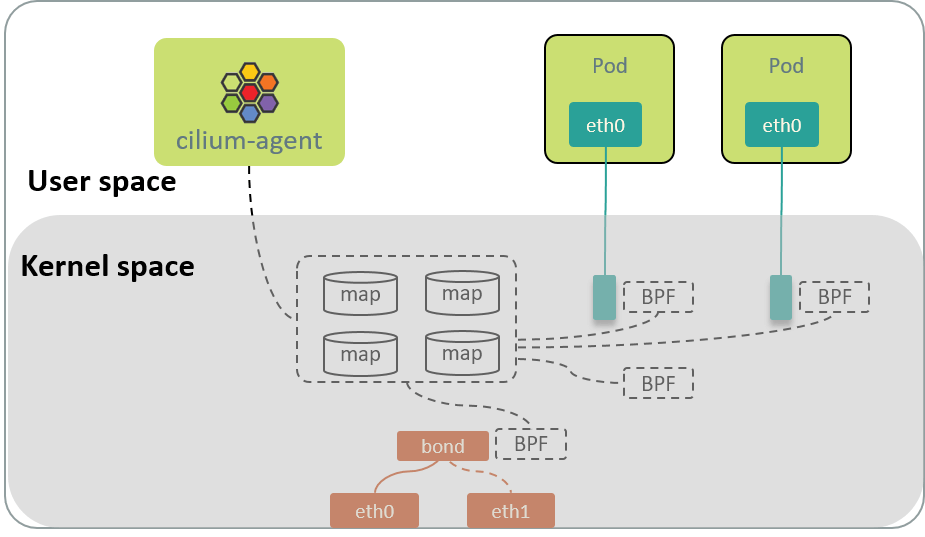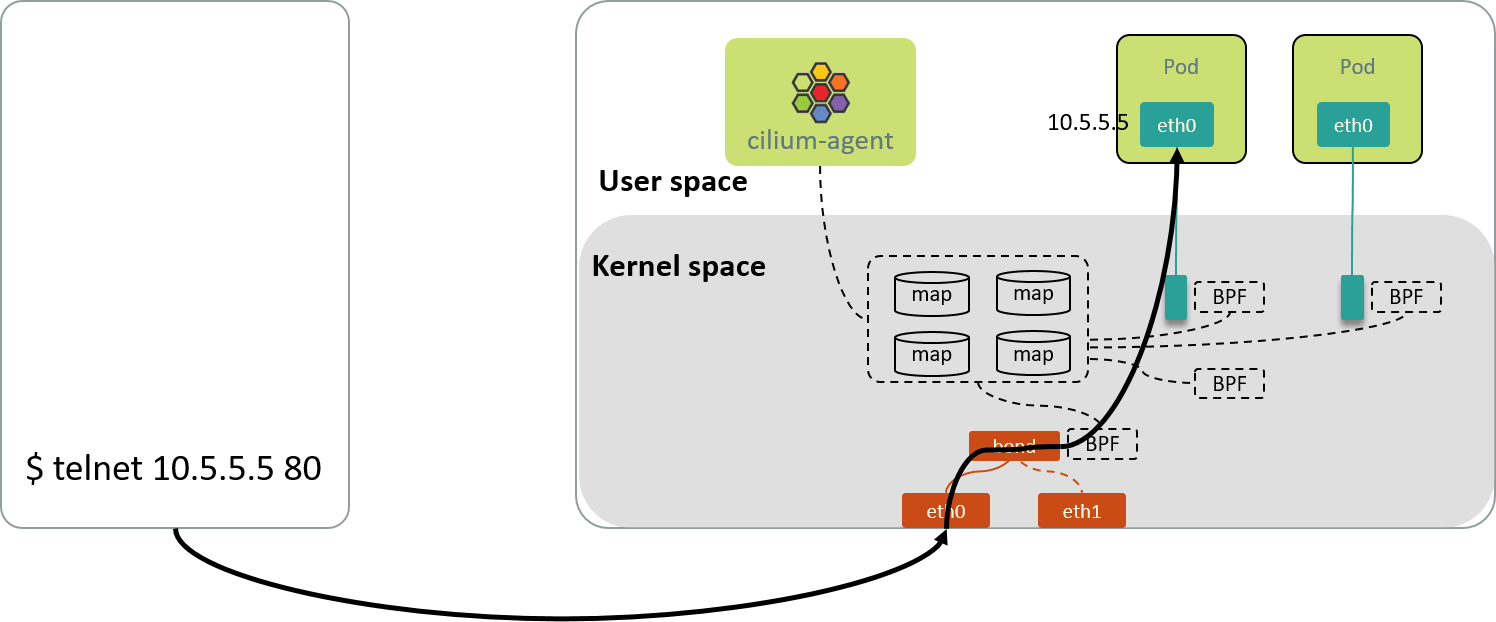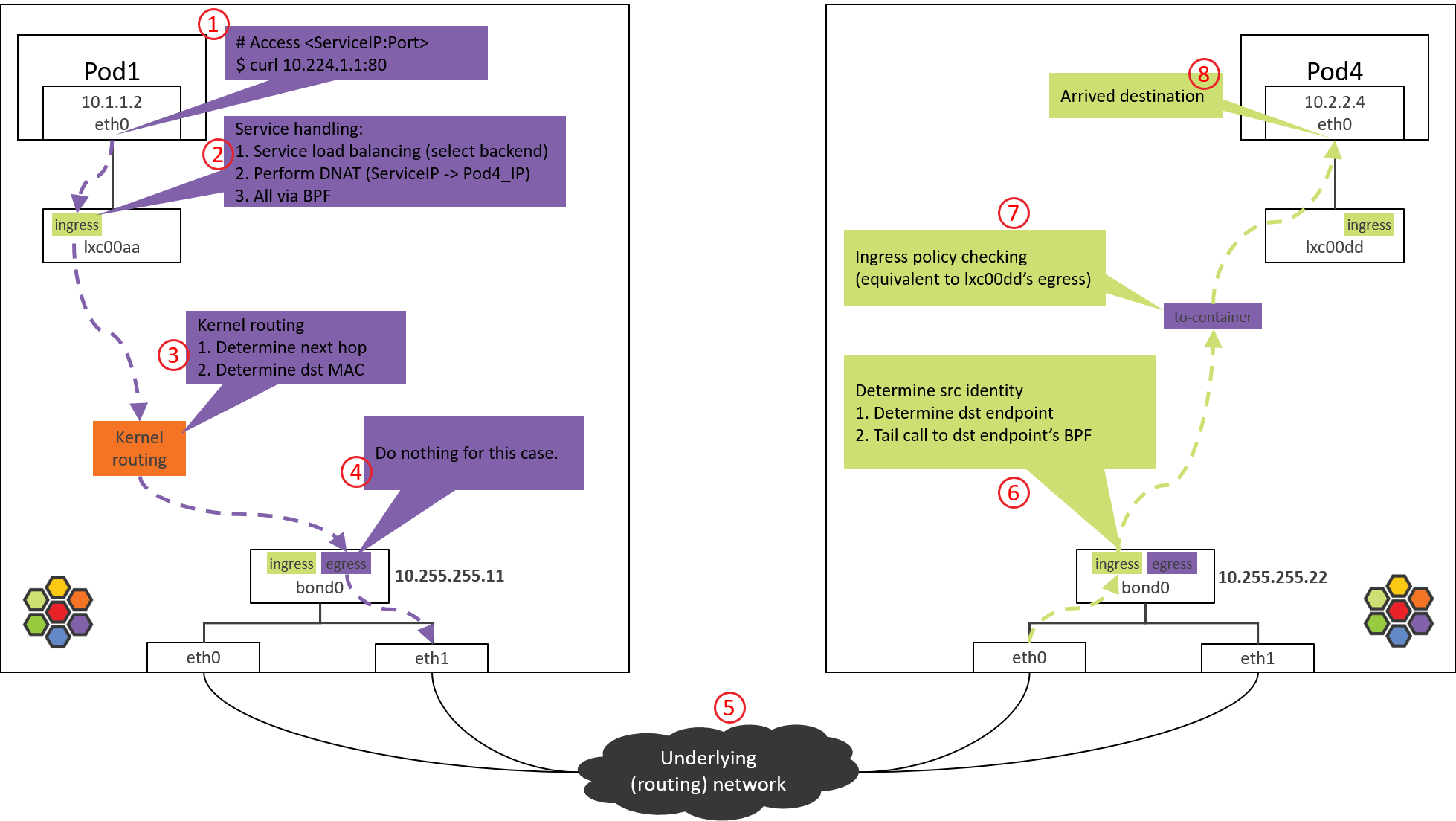Cilium: Handle Conntrack (CT) related BPF Maps on Agent Restart
This post digs into the handling of CT (conntrack) related BPF
maps during agent restart. Code based on Cilium 1.9.5.

If you’re not familiar with CT, refer to Connection Tracking (conntrack): Design and Implementation Inside Linux Kernel [5] for some basic concepts.
This post is included in the Cilium Code Walk Through Series.
- 1 Prerequisites and background knowledge
- 2 Functionality test: adjust CT table (map) size
- 3 The code: BPF maps handling on agent restart
- 3.1 High-level overview (call stack)
- 3.2 Init map info from agent configurations:
ctmap.InitMapInfo() - 3.3 Init map objects:
initMaps() - 3.4
m.Create() -> m.OpenOrCreate() -> m.openOrCreate() -> Remove() && OpenOrCreateMap() - 3.5
OpenOrCreateMap() -> objCheck() -> Remove() && recreate -> CreateMap() - 3.6 The final creation:
CreateMap() -> unix.SysCall()
- 4 Back to the functionality test
- 5 Conclusion and future work
- References
1 Prerequisites and background knowledge
1.1 BPF maps
BPF map is a BPF in-kernel infrastructure for efficient key-value storage, which also serves as a fashion for sharing data among:
- Different BPF programs
- Kernel and userspace programs
As depicted below:

Fig 1. BPF maps, BPF programs and userspace programs on a Cilium node
BPF maps (objects) could be pinned to BPFFS, which make them survivable to agent restarts and node reboots.
1.2 BPF maps in Cilium
Cilium agent relies heavily on BPF maps, most of which are pinned to bpffs. Let’s first have a glimpse of them on a worker node:
root@node:/sys/fs/bpf/tc/globals $ ls
cilium_call_policy cilium_calls_00571 cilium_calls_hostns_01320 cilium_calls_netdev_00008 cilium_ct4_global
cilium_ct_any4_global cilium_encrypt_state cilium_events cilium_ipcache cilium_ipv4_frag_datagrams
cilium_lb4_affinity cilium_lb4_backends cilium_lb4_reverse_nat cilium_lb4_services_v2 cilium_lb_affinity_match
cilium_lxc cilium_metrics cilium_policy_01955 cilium_signals cilium_tunnel_map
...
The above maps can be groupped by their functionalities:
-
Tail call
cilium_calls_<ep_id>cilium_calls_hostns_<ep_id>cilium_calls_netdev_<ep_id>
Used for tail calling between different BPF programs.
Tail call is a special form of function call, see [1] for how tail calls are performed in Cilium.
-
Connection tracking (conntrack, CT)
cilium_ct4_globalcilium_ct4_<ep_id>: if per-endpoint CT (ConntrackLocal=true) is enabledcilium_ct_any4_global
Used for connection tracking purpose [2].
-
Encryption
cilium_encrypt_state
-
Load balancing, or K8s Service handling
cilium_lb4_xxx
For client-side load balancing, e.g. K8s Service handling (mapping ServiceIP/ExternalIPs/NodePorts to backend PodIPs). Refer to [3] for more information.
-
Network policy
cilium_policy_<ep_id>
For enforcing CiliumNetworkPolicy (CNP), which implements and extends K8s’s NetworkPolicy model.
-
events, metrics, etc
1.3 Inspect CT entries in Cilium
(node) $ cilium bpf ct list global | head
TCP IN 192.168.139.13:44808 -> 192.168.64.97:4240 expires=3553147 RxPackets=6 RxBytes=506 RxFlagsSeen=0x03 LastRxReport=3553137 TxPackets=4 TxBytes=347 TxFlagsSeen=0x03 LastTxReport=3553137 Flags=0x0013 [ RxClosing TxClosing SeenNonSyn ] RevNAT=0 SourceSecurityID=2 IfIndex=0
TCP OUT 192.168.54.113:36260 -> 192.168.198.12:4240 expires=3553014 RxPackets=14 RxBytes=1090 RxFlagsSeen=0x03 LastRxReport=3553004 TxPackets=9 TxBytes=704 TxFlagsSeen=0x03 LastTxReport=3553004 Flags=0x0013 [ RxClosing TxClosing SeenNonSyn ] RevNAT=0 SourceSecurityID=0 IfIndex=0
TCP OUT 192.168.54.113:39298 -> 192.168.245.13:4240 expires=3553107 RxPackets=14 RxBytes=1090 RxFlagsSeen=0x03 LastRxReport=3553097 TxPackets=9 TxBytes=704 TxFlagsSeen=0x03 LastTxReport=3553097 Flags=0x0013 [ RxClosing TxClosing SeenNonSyn ] RevNAT=0 SourceSecurityID=0 IfIndex=0
...
2 Functionality test: adjust CT table (map) size
If CT table is full because there are so many connections, we have to adjust the table size (equivalent to CT map size), such as, through CLI parameters:
--bpf-ct-global-any-max=262144--bpf-ct-global-tcp-max=524288
then restart the agent to load the configuration changes.
2.1 Concern: will existing connections be interrupted?
The question is: will this operation disrupt the existing connections?
For example, there are already hundreds of thousands of established connections on this node.
Let’s test it.
2.2 Test case 1: inbound connection
First, test the inbound/ingress connections to the Pods on this node, as illustrated below:

Fig 2.1 Inbound connection: access pod from other nodes
Step 1. Create an inbound connection
On another node: initiate a TCP connection and leave it there,
(node2) $ telnet 10.5.5.5 80
Connected to 10.5.5.5.
Escape character is '^]'.
Step 2. Enlarge CT (map) size and restart agent
We use docker-compose to manage cilium-agents [4,6], so it is quite easy:
(node1) $ cd cilium-compose
(node1) $ sed -i 's/524288/1048576/g' mount/configmap/bpf-ct-global-tcp-max
(node1) $ sed -i 's/262144/524288/g' mount/configmap/bpf-ct-global-any-max
(node1) $ docker-compose down && docker-compose up -d
Step 3. Check connection liveliness
Back to node2, first noticed that our connection is not disconnected but still alive:
(node2) $ telnet 10.5.5.5 80
Connected to 10.5.5.5.
Escape character is '^]'.
Then let’s resume this connection by sending some data: typing
something (e.g. aaaaa) then press Enter,
(node2) $ telnet 10.5.5.5 80
Connected to 10.5.5.5.
Escape character is '^]'.
aaaaa
HTTP/1.1 400 Bad Request
Server: nginx/1.11.1
...
The pod returns HTTP 400 errors, which indicates that our TCP
connection is still OK (400 is a L7 error code, because we
typed some invalid HTTP data, which means L4 is OK).
2.3 Test case 2: outbound Service connections
This test case is different in that, the connection is targeted to a ServiceIP, so client side service handling, or DNAT (ServiceIP->PodIP) to be specific, will be performed. Take a picture from [5]:

Fig 2.2. Traffic path of Pod-to-ServiceIP
Create connection with command:
(pod on node1) $ telnet <ServiceIP> <Port>
The other steps are similar. Omit here for simplicity.
The result of our test: the connction will not be interrupted either.
2.4 Summary
Now we may wonder: how does cilium-agent handles the table/map changes on restart?
In the next, we’ll explore the details in Cilium’s design and implementation.
3 The code: BPF maps handling on agent restart
3.1 High-level overview (call stack)
Below is the high-level calling stack of the BPF maps handling logic:
runDaemon // daemon/cmd/daemon_main.go
|-NewDaemon // -> daemon/cmd/daemon.go
|-ctmap.InitMapInfo(conf)
| |-setupMapInfo(conf)
| |-"save map conf to mapInfo[], for later use"
|
|-d.initMaps() // Open or create BPF maps. // daemon/cmd/datapath.go
|-lxcmap.LXCMap.OpenOrCreate // "cilium_lxc"
|-ipcachemap.IPCache.OpenParallel // "cilium_ipcache"
|-tunnel.TunnelMap.OpenOrCreate //
|-supportedMapTypes := probe.GetMapTypes
|-d.svc.InitMaps //
|-policymap.InitCallMap // "cilium_call_xxx"
|
|-for ep in endpoints:
| ep.InitMap // -> pkg/endpoint/bpf.go
| |-policymap.Create(e.policyMapPath)
|
|-for ep in endpoints:
| if ep.ConntrackLocal():
| for m in ctmap.LocalMaps: // "cilium_ct4_<ep_id>", "cilium_ct_any4_<ep_id>"
| m.Create()
|
|-ctmaps = ctmap.GlobalMaps: // pkg/maps/ctmap/ctmap.go
| |-maps(nil, ipv4, ipv6)
| |-newMap
| |-&Map(MapTypeLRUHash)
|-for m in ctmaps: // "cilium_ct4_global", "cilium_ct_any4_global"
| m.Create // -> pkg/bpf/map_linux.go
| |-OpenOrCreate
| |-openOrCreate
| |-OpenOrCreateMap // -> pkg/bpf/bpf_linux.go
|
|-for m in nat.GlobalMaps:
m.Create // global NAT maps
3.2 Init map info from agent configurations: ctmap.InitMapInfo()
During agent restarting, one step is to save the user specified
map configurations to a package-level variable
mapInfo map[mapType]mapAttributes, by calling runDaemon() -> ct.InitMapInfo()
// daemon/cmd/daemon.go
ctmap.InitMapInfo( // Corresponding CLI or configmap options:
Config.CTMapEntriesGlobalTCP, // --bpf-ct-global-tcp-max=524288
Config.CTMapEntriesGlobalAny, // --bpf-ct-global-any-max=262144
Config.EnableIPv4, // --enable-ipv4
Config.EnableIPv6, // --enable-ipv6
Config.EnableNodePort) // --enable-node-port
where ctmap.InitMapInfo() is defined as:
// pkg/maps/ctmap/ctmap.go
var mapInfo map[mapType]mapAttributes // package-level variable, holding CT maps' configurations
// Build information about different CT maps for the combination of L3/L4 protocols,
// using the specified limits on TCP vs non-TCP maps.
func InitMapInfo(tcpMaxEntries, anyMaxEntries int, v4, v6, nodeport bool) {
global4Map, global6Map := nat.GlobalMaps(v4, v6, nodeport) // global CT maps
natMaps := map[mapType]*nat.Map{
mapTypeIPv4TCPLocal: nil, // SNAT only works if CT map is global
mapTypeIPv4TCPGlobal: global4Map,
mapTypeIPv4AnyGlobal: global4Map,
}
// CT_TYPE NAME KEY MAP_SIZE CORRESPONDING_NAT_MAP
setupMapInfo(IPv4TCPLocal, "CT_MAP_TCP4", &CtKey4{}, mapNumEntriesLocal, natMaps[typeIPv4TCPLocal])
setupMapInfo(IPv4TCPGlobal, "CT_MAP_TCP4", &CtKey4Global{}, tcpMaxEntries, natMaps[typeIPv4TCPGlobal])
setupMapInfo(IPv4AnyLocal, "CT_MAP_ANY4", &CtKey4{}, mapNumEntriesLocal, natMaps[typeIPv4AnyLocal])
setupMapInfo(IPv4AnyGlobal, "CT_MAP_ANY4", &CtKey4Global{}, anyMaxEntries, natMaps[typeIPv4AnyGlobal])
}
func setupMapInfo(m mapType, define string, mapKey bpf.MapKey, keySize int, maxEntries int, nat *nat.Map) {
mapInfo[m] = mapAttributes{
bpfDefine: define,
mapKey: mapKey,
mapValue: &CtEntry{}, // for all CT maps, value type is the same: "struct CtEntry"
maxEntries: maxEntries,
parser: bpf.ConvertKeyValue,
natMap: nat,
}
}
When later the CT related BPF maps are being initialized,
they will retrieve map configurations from here (the configuration store var mapInfo[]).
3.3 Init map objects: initMaps()
After map configurations are parsed and saved, the next step is to create, remove or recreate them according to configuration changes.
Let’s concentrate on CT related code:
d.initMaps() // Open or create BPF maps. // daemon/cmd/datapath.go
|-...
|
|-for ep in endpoints:
| if ep.ConntrackLocal():
| for m in ctmap.LocalMaps: // "cilium_ct4_<ep_id>", "cilium_ct_any4_<ep_id>"
| m.Create()
|
|-ctmaps = ctmap.GlobalMaps:
| |-maps(nil, ipv4, ipv6)
| |-newMap
| |-&Map(MapTypeLRUHash)
|-for m in ctmaps: // "cilium_ct4_global", "cilium_ct_any4_global"
| m.Create // -> pkg/bpf/map_linux.go
| |-OpenOrCreate
| |-openOrCreate
| |-OpenOrCreateMap // -> pkg/bpf/bpf_linux.go
|
|-for m in nat.GlobalMaps: // global NAT maps
m.Create
ConntrackLocal or non-ConntrackLocal (default)
Cilium supports to store all CT entries into a global CT talbe (by default),
as well as store each endpoint’s CT entries into their own CT tables (runtime
option ConntrackLocal=true, but this option is broken currently).
Despite its somewhat misleading name,func (m *Map) Create() is actually the
entrypoint for creating/opening/removing/recreating a map.
It is similar to OpenOrCreate(), but closes the map after creating or opening it.
We’ll follow these methods later.
Init global CT maps
The agent will always re-initialize the global CT maps by calling m.Create().
3.4 m.Create() -> m.OpenOrCreate() -> m.openOrCreate() -> Remove() && OpenOrCreateMap()
Open or create maps:
// pkg/bpf/map_linux.go
func (m *Map) Create() (bool, error) {
isNew := m.OpenOrCreate()
return isNew, m.Close()
}
m.OpenOrCreate() is again a wrapper, it calls an internal method m.openOrCreate():
// Returns whether the map was deleted and recreated, or an optional error.
func (m *Map) OpenOrCreate() (bool, error) {
return m.openOrCreate(true)
}
func (m *Map) openOrCreate(pin bool) (bool, error) {
m.setPathIfUnset()
if m.NonPersistent { // If the map represents non-persistent data,
os.Remove(m.path) // always remove it before opening or creating.
}
flags := m.Flags | GetPreAllocateMapFlags(mapType)
fd, isNew := OpenOrCreateMap(m.path, mapType, m.KeySize, m.ValueSize, m.MaxEntries, flags, m.InnerID, pin)
registerMap(m.path, m)
return isNew, nil
}
Logic of the method:
-
If the map is marked as non-persistent, remove the map and it will later be recreated.
-
If the existing map's attributes such as map type, key/value size, capacity, etc. changed, then the map will be deleted and reopened without any attempt to retain its previous contents. This attributes-checking process is done in
OpenOrCreateMap(), we’ll see it later.This means that when we change the map size with
--bpf-ct-global-tcp-max=xxxthen restart the agent, the corresponding original/existing BPF map will always be deleted.
3.5 OpenOrCreateMap() -> objCheck() -> Remove() && recreate -> CreateMap()
Continue the calling stack:
// pkg/bpf/bpf_linux.go
func OpenOrCreateMap(path, mapType, keySize, valueSize, maxEntries, flags, innerID, pin bool) (int, bool, error) {
redo := false
isNewMap := false
recreate:
create := true
// Step 1. ensure map directory exists
if pin {
if os.NotExist(path) || redo {
os.MkdirAll(filepath.Dir(path), 0755)
} else {
create = false
}
}
// Step 2. create map if not exist, then return
if create {
fd = CreateMap(mapType, keySize, valueSize, maxEntries, flags, innerID, path)
isNewMap = true
if pin {
ObjPin(fd, path)
}
return fd, isNewMap, nil
}
// Step 3. map already exists, check if there are any map attribute changes,
// if there is, delete the existing map
fd = ObjGet(path)
redo = objCheck(fd, path, mapType, keySize, valueSize, maxEntries, flags)
// Step 4. recreate the map if there are attribute changes
if redo == true {
ObjClose(fd) // close FD of existing map
goto recreate
}
return fd, isNewMap, err
}
Logic:
- if map not exist: create the map by calling
fd = CreateMap() -
if map already exists: call
objCheck()to see if there are any map attribute changes, and if there is, it will- remove the existing map, then
- return
hasChanged=trueto the callerOpenOrCreateMap(), which will create a map (remove+create=re-create).
// pkg/bpf/bpf_linux.go
func objCheck(fd, path, mapType, keySize, valueSize, maxEntries, flags uint32) bool {
info := GetMapInfo(os.Getpid(), fd)
mismatch := false
if info.MapType != mapType || info.KeySize != keySize ||
info.ValueSize != valueSize || info.MaxEntries != maxEntries || info.Flags != flags {
Warn("XX mismatch for BPF map")
mismatch = true
}
if mismatch {
if info.MapType == MapTypeProgArray {
return false
}
Warning("Removing map to allow for property upgrade (expect map data loss)")
os.Remove(path) // Kernel still holds map reference count via attached prog.
return true // Only exception is prog array, but that is already resolved differently.
}
return false
}
3.6 The final creation: CreateMap() -> unix.SysCall()
// pkg/bpf/bpf_linux.go
// When mapType is the type HASH_OF_MAPS an innerID is required to point at a
// map fd which has the same type/keySize/valueSize/maxEntries as expected map
// entries. For all other mapTypes innerID is ignored and should be zeroed.
func CreateMap(mapType, keySize, valueSize, maxEntries, flags, innerID, path) (int, error) {
uba := struct {
mapType uint32
keySize uint32
valueSize uint32
maxEntries uint32
mapFlags uint32
innerID uint32
}{ uint32(mapType), keySize, valueSize, maxEntries, flags, innerID }
unix.Syscall(unix.SYS_BPF, BPF_MAP_CREATE, uintptr(unsafe.Pointer(&uba)), unsafe.Sizeof(uba))
runtime.KeepAlive(&uba)
return int(ret), nil
}
4 Back to the functionality test
After a tour to the code, we can back to our previous test and find more information.
4.1 Agent logs on BPF removing
First, we could see from the code in Section 3.5 that, when map attributes are changed, agent will remove the old map and create a new one, and logging a warning about this, as the old data is deleted during this process:
level=warning msg="Max entries mismatch for BPF map" file-path=/sys/fs/bpf/tc/globals/cilium_ct4_global new=624288 old=524288
level=warning msg="Removing map to allow for property upgrade (expect map data loss)" file-path=/sys/fs/bpf/tc/globals/cilium_ct4_global
4.2 Check CT entries during agent restart
We could also check the CT table contents during each step in Section 2.2:
After connection established
$ cilium bpf ct list global 2>&1 | grep 192.168.64.195 | grep TCP
TCP IN 10.5.224.91:40356 -> 192.168.64.195:6379 expires=3295721 RxPackets=14 RxBytes=983 ...
CT entry created.
After configuration changed and agent restarted
$ cilium bpf ct list global 2>&1 | grep 192.168.64.195 | grep TCP
# nothing found
CT entry disappeared.
After we’ve sent some data
$ cilium bpf ct list global 2>&1 | grep 192.168.64.195 | grep TCP
TCP IN 10.5.224.91:40356 -> 192.168.64.195:6379 expires=3295750 RxPackets=2 RxBytes=140 RxFlagsSeen=0x02 ...
CT entry "came back", but notice that all statistics, e.g. RxPackets, RxBytes has been reset. The reason is that, as the code has shown, it won’t dump existing data when re-creating a map.
5 Conclusion and future work
According to our test, when changing CT table sizes, existing CT entries will be flushed, but the existing connections won’t be interrupted.
More code should be digged into to explain why. May update later.
References
- Life of a Packet in Cilium: Discovering the Pod-to-Service Traffic Path and BPF Processing Logics
- Connection Tracking (conntrack): Design and Implementation Inside Linux Kernel.
- L4LB for Kubernetes: Theory and Practice with Cilium+BGP+ECMP
- Trip.com: First Step towards Cloud Native Networking
- Life of a Packet in Cilium: Discovering the Pod-to-Service Traffic Path and BPF Processing Logics
- https://github.com/ctripcloud/cilium-compose